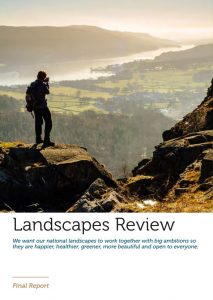Review of The Glover Report: Landscapes Review, Final Report by Julian Glover, September 2019. 168pp
The author is Julian Glover, an associate editor at the London Evening Standard and has worked as a leader writer at The Guardian and as a Special Advisor to Number 10. His stated aims are to respect two emotions, i) that there is great quality within AONBs and National Parks (NPs) already protected and ii) that these areas are fragile and ‘that nature in them is in crisis as elsewhere, that communities are changing and that many people do not know these places.’
There is not a lot about habitat loss in this Review, more about how these natural assets can be managed. It is fairly dismissive of the way they are run at present, and proposes bringing National Parks (10) and AONBs (34) together as ‘one family of national landscapes, served by a shared National Landscapes Service (NLS). This fits in with the government’s green agenda.
It is thought that the AONB acronym is too ‘cumbersome’ and both AONBs and NPs should now be called ‘National Landscapes’. These landscapes amount to 24.5% of England (44 ‘disparate bodies’) with room to grow? This document is thus an entrée to introduce a new government body.
It is however up to date with the February 2019 NPPF and emphasises paragraph 172 on great weight should be given to conserving and enhancing….AONBs. It goes on to say..,,,”we urge the government to give the strongest emphasis to its commitment to our national landscapes.” “They should not be the place for major intrusive developments unless, as is stated in the NPPF, they are truly in the national interest without any possible alternative locations being available’ (p63).
On biodiversity loss they quote the National Trust who said “We believe that National Parks and AONBs are not currently delivering on their duty in relation to nature”. They think that Management Plans should be strengthened, and ‘given statutory consultee status, encouragement to develop local plans and changes to the National Planning Policy Framework’.
In protecting what is present it refers to the government’s 25 Year Environment Plan (2018) which sets out a clear ambition: “we want to improve the UK’s air and water quality and protect our many threatened plants, trees and wildlife species.”
The report finds that the current purpose of AONBs in relation to ‘natural beauty’, and ‘wildlife’ and ‘conserve and enhance’ do not reflect the wider scientific ideas embodied in ‘biodiversity’, ‘nature’ ‘natural capital’ or ‘ecosystem services’ . These are fairly damning statements.
In an earlier document, Glover cites the International Union for Conservation of Nature (IUCN) ‘Putting Nature on the Map (2016), pointing out the recognition of significant ecological, biological, cultural and scenic value by the IUCN as being of national landscape interest and it fits with their ‘Category V’ for the UK.
Regarding access, Glover reminds us that AONBs are now designated under the Countryside and Rights of Way Act 2000, still only have a single purpose, and only in relation to ‘natural beauty’. ‘indeed we want to see walking further supported by national landscapes taking on rights of way management and the National Landscapes Service supporting National Trails. But it feels wrong that many parts of our most beautiful places are off limits to horse riders, water users, cavers, wild campers and so on. We hope that as part of the government’s commitment to connect more people with nature, it will look seriously at whether the levels of open access we have in our most special places are adequate.
The report highlights the exemplary rewilding work on the large Knepp Wildlife Project in West Sussex and as a reflection of the way that wildlife assessments are going its Proposal 2, is The state of nature and natural capital in our national landscapes should be regularly and robustly assessed, informing the priorities for action.
